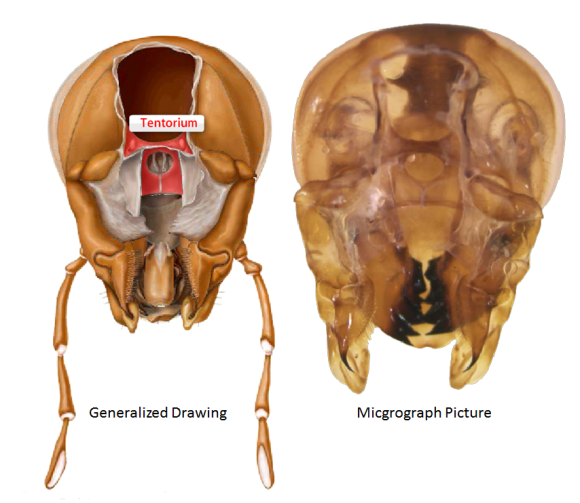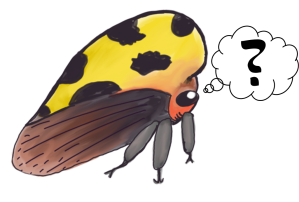Written by Nancy Miorelli
Cockroaches (Blattodea) and Mantises (Mantodea). They’re both insects. They’ve got their six legs, three segmented body parts, and a Johnston’s organ which guarantee them a spot in the class Insecta. But as it turns out, they’re more closely related than that.
So what makes these guys “birds of a feather?”
A superorder called “Dictyoptera”.
Once upon a time in like 5th grade or something, you may have been told to memorize the classification system of animals, likely with a (potentially R-rated) mnemonic: Kingdom, Phylum, Class, Order, Family, Genus, Species. Well, there are some other classifications frequently tossed about too.
Orders can have “super”s and “sub”s. Super orders are above the order classification and below the class. Suborders are below the order classification and above the family. Families get supers and subs too. Mantises and roaches are related because they’re in the same Superorder – Dictyoptera.

The suborder Dictyoptera includes cockroaches and mantis.
It’s believed now that termites (Isoptera) are included in the cockroach order (Blattodea).
PC: Tree of Life Web Project
“But why!?” you ask. Cockroaches and mantises look nothing like each other! One is a majestic beast, faithfully defending your gardens from an onslaught of herbivorous chaos, and the other finds joy scaring your sister and finding refuge in your cabinets. [Note: slight exaggeration]
This is because things that regular people would use to group organisms together, like color or body shape, aren’t the things that taxonomists use. Color patterns and body shapes aren’t indicative of relationships because they arise out of necessity due to the environmental pressures.
So mantises and roaches are related due to a bunch of things I’m going to need pictures to explain. The pictures mainly come from cockroaches because they’re considerably more well studied than mantises due to their economic pest status. So here are some of the major morphologies that group mantises and cockroaches together.
Specialized Egg Cases
As Joe mentioned in an earlier post, mantises lay egg cases called oothecae. In addition to a cluster of eggs, the female secretes proteins that harden into a styrofoam-like consistency. In many cockroaches, the ootheca hardens and the outside obtains a kind of smooth leathery feel.

They make these things to make babies.
PC: Kropsoq (CC by SA 3.0)
Bernard DUPONT (CC by SA 2.0)
Enlarged Subgenital Plate
It’s a plate underneath the sexy bits. They come in various shapes and sizes and are sometimes divided in female cockroaches. The important part is that they’re a lot bigger in cockroaches and mantises compared to other insects.
Perforated Cephalic Tentorium
The Tentorium is a sclerotized structure inside the head of insects. It’s kind of like a piece of a skull, if insects had that sort of thing. Basically, it’s a hard structure which some muscles are hooked up to and generally helps structurally support the head. Anyway, in mantises and roaches, it has some tiny holes in it.

The Cephalic Tentorium in cockroaches.
PC: The Virtual Roach by Joe McHugh and Gene N. Wright
Toothed Proventriculus
Insects’ digestive systems are kind of like ours in the fact that they have some mouth bits on the outside, an esophagus (foregut), a stomach (midgut), and a large intestine for reabsorbing nutrients and pooping (Malphigian tubules). Insects have a few other parts, including a proventriculus that’s located at the end of the foregut and the beginning of the midgut. It’s called the same thing in birds, but you probably know it as a gizzard. It helps grind up solid food. Unlike in other insects, in mantises and roaches proventriculus has structures that look like shark teeth.

Left: The generalized cockroach digestive system. The proventriculus is highlighted.
PC: The Virtual Roach. Joe McHugh and Greene N. Wright
Right: The toothed proventriculus in two cockroach species.
PC: Miller and Fisk, 1970
TL;DR
Mantises and Cockroaches don’t outwardly look very similar. However, they’re in the same superorder called Dictyoptera. This is because there are some physiological and anatomical subtleties that group these guys together. They include production of oothecae, an enlarged subgenital plate, a perforated cephalic tentorium, and a toothed proventriculus.

Sister groups in taxonomy are the closest relatives in a phylogenetic tree. Drawing by Nancy Miorelli
Thanks:
To Joe Ballenger for fact checking my drawings.
To Matt Zawodniak who heroically trudged his way to the library for me to get the in-print version of one of the articles since the internet failed me.
Links You Should Check Out
The Virtual Roach – you can interactively dissect a cockroach and it has SEMs and microphotographs you can check out that are awesome.
These simplified drawings by R. Fox which were very helpful in navigating my way around a cockroach.
References:
-
Inward D. Beccaloni G. Eggleton P. 2007. Death of an order: a comprehensive molecular phylogenetic study confirms that termites are eusocial cockroaches. Biology letters 3(3): 331–335.
-
Lopes SM and Heeren de Oliveria E. New group, new species, and new records from Brazil of the atrops, brasilianus, and giganteus groups (Blattaria, Blaberidae, Blaberinae). Biota Neotropical 13(2): ISSN 1676-0603
- Miller KH and Fisk FW. 1970. Taxanomic implications of the comparative morphology of cockroach proventriculi. Annals of the Entomological Society of America 64(3):671-680.
-
Wang X, Shi Y, Wang Z, Che Y. 2014. Revision of the genus Salganea Stål (Blattodea, Blaberidae, Panesthiinae) from China, with descriptions of three new species. Zookeys 412: 59-87.
-
Wipfler B, Wieland F, Decarlo F, Hörnschemeyer T. 2012. Cephalic morphology of Hymenocoronatus coronatus (Insecta: Mantodea) and its phylogenetic implications. Arthropod Structure and Development 41(1): 87-100.






Pingback: Update to previous post: Unlikely Sisters | Ask an Entomologist
Pingback: Cute critters | Berowra backyard
This was quite interesting
LikeLike